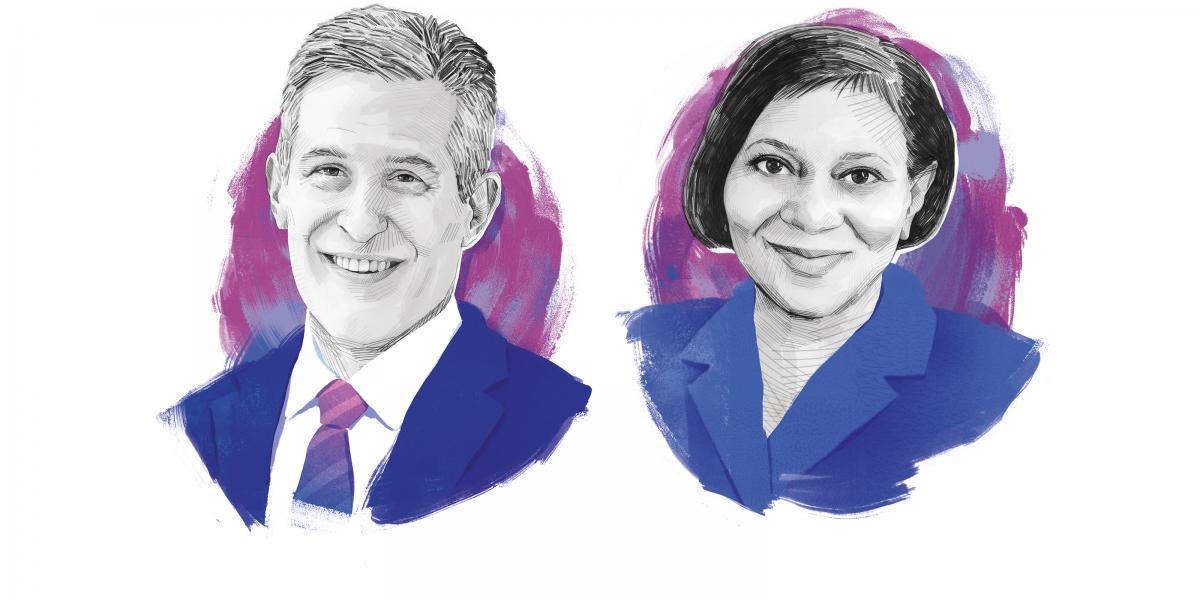RWJF’s Richard Besser and Health Disparities Expert Lisa Cooper on Reducing Health Inequities
Uncovering the power of communities to resolve inequities and shape health.
Improving America’s health must start with a bigger and more inclusive conversation about opportunity, say Lisa A. Cooper, MD, MPH ’93, a Bloomberg Distinguished Professor in Health, Behavior and Society and in Medicine, and Richard Besser, MD, president and CEO of the Robert Wood Johnson Foundation. If people don’t have the opportunity to eat healthy or get exercise, then health is not going to improve, they say. Besser and Cooper, director of the Johns Hopkins Center for Health Equity, share big-picture thoughts on how wages, housing and transportation influence health and how communities can mobilize to create environments where health can thrive.
LC: Traditionally, those of us in medicine and the health care field, and even maybe the public, have thought about health as something that happens when you go to the doctor’s office or something specifically related to your own health behaviors and your own family history. How do you think we can change the way people think about health to reduce inequities?
RB: I think if we don’t make the connection between someone’s health status and their opportunity to lead a healthy life, we’re not going to see an improvement in the health of all. It’s making clear to people that housing and transportation and jobs that pay living wages and access to food and safe neighborhoods are critically important to health status.
LC: You mentioned the word opportunity, and I like to say that people’s choices are shaped by the opportunities they have. So you might want to be physically active or you might want to eat healthy, but you may not have those options. You might not live in a neighborhood where there are facilities where you can be physically active or where you feel safe to do that. Or you might not be able to get the kinds of foods that would help you stay healthy.
Opportunities are shaped by things that people may not traditionally think of as being related to health. So, the decisions we make and the policies we have about things in our society, like education, wages and all the things you mentioned, can have consequences on people's ability to stay or become healthy.
I think if we don’t make the connection between someone’s health status and their opportunity to lead a healthy life, we’re not going to see an improvement in the health of all.
RB: You said that really well. I’m a general pediatrician. I think about the number of times in the past I must have talked to a parent about their child and the things that they can do to ensure that their child grows up healthy, without reflecting on, what are the opportunities for this family to do those things that I’m suggesting? The choices people make depend on the choices that they have, and for far too many people in America, the healthy choices really aren’t there. Simple things like preparing a healthy meal or getting an hour of physical activity each day—for some people in some communities, those are
a nonstarter.
LC: One of the things I’ve learned, and that the data show, is that when there is health inequity in a society, everyone is negatively impacted, even people who are pretty advantaged and have a lot of resources. Just seeing the negative effects of those things can have a negative effect on you emotionally, stresswise. It can also make you feel unsafe.
The fact that other people are not healthy affects everyone. We pay for it through our insurance, through our taxes, all of those things.
RB: I think you really hit the nail on the head. There’s the importance of making health a shared value so that we’re not only thinking about our health, but we’re also seeing the value in other people having the opportunity for health.
We give out prizes each year called Culture of Health Prizes. And they recognize communities in America that have come together to solve their own problems. One of those communities was in Allen County, Kansas. It’s a rural area in central Kansas that recognized that they had a problem. While they loved living in this county, they were seeing issues in terms of unemployment [and] despair.
What started out as efforts to attract business to their community really became seen as well as a major health initiative. They turned an old closed-down factory into walking and hiking trails. They recruited a supermarket to come into the community so that they would have access to fresh fruits and vegetables. And they even passed a sales tax to allow them to reopen and attract a hospital.
LC: Some of these themes remind me of an intervention that occurred across a set of rural counties in Maine. A group of people from many different sectors of the community came together to focus on specific cardiovascular risk factors, like high cholesterol and hypertension. And they focused on not just one behavior, but multiple factors, like diet and smoking and physical activity. There were people from the main hospital in the area. There were clinical providers. There were faith groups, employers. There were schools. The goal was to get people screened and detected earlier, and then linked to appropriate services for treatment.
Over 40 years, they were able to show a marked reduction in heart disease rates and death rates. Success stories tend to happen when people in a community, especially those who are impacted by health inequities, come together from multiple vantage points and use their resources, expertise and lived experiences to implement solutions that are practical and sustainable.
